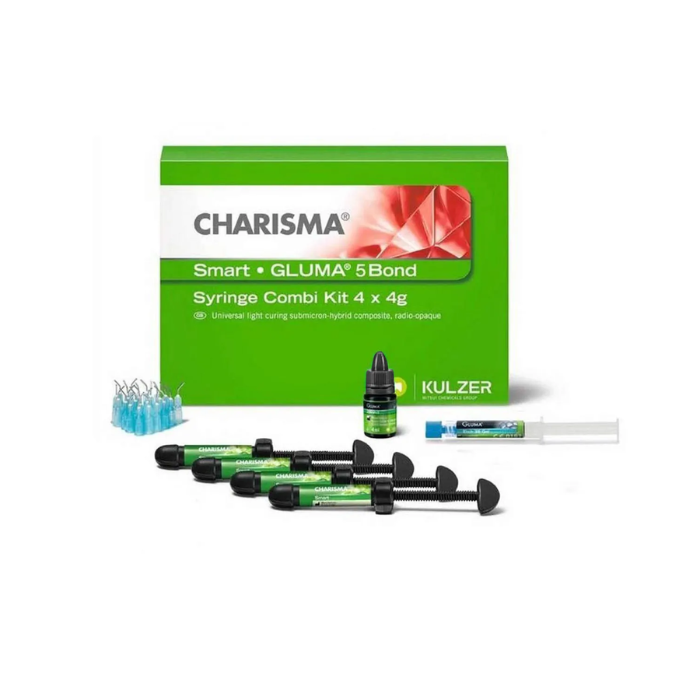Kulzer Charisma Smart Composite 4 Syringe Kit
Charisma Smart is a light-cured, radio-opaque submicron hybrid composite (Microglass®) for tooth-colored restorations. Suitable for both anterior and posterior applications, it does not contain Bisphenol-A and is ideal for various dental repair and restoration needs.
Delivery Time
- Upto 7 days
Features:
- Color-Stabilizing Technology: Ensures long-lasting, stain-resistant composite restorations with minimal maintenance, delivering natural results effortlessly.
- Ease of Handling and Vital Shades: Designed for straightforward single-shade layering, Charisma Smart offers excellent handling and modeling properties, making it ideal for natural-looking everyday restorations.
Indications:
- Direct restoration of Class I – V cavities.
- Tooth shape corrections, including diastemas and congenital defects.
- Splinting of teeth affected by trauma or periodontal issues.
- Restoration of primary teeth and repairs of porcelain or composite materials.
| Technical Specification | COMPOSITION:
Light intensity
Instructions:
Storage:
Contraindications:
Side effects:
Precautions: 1.Avoid contact with skin. Wear suitable protective gloves. In case of contact with skin, immediately wash with plenty of water and soap. May cause sensitisation by skin contact. 2.Avoid contact with eyes. Immediately and thoroughly rinse with plenty of water in case of contact with eyes and contact an ophthalmologist. 3.In the case of deep cavity preparations in close proximity to the pulp or a direct pulpal exposure, cover the dentine or the exposure locally with a calcium hydroxide liner covered with a glass ionomer cement before applying the adhesive.
4. Composites should only be used when having reached room temperature. |
|---|
- 4 x 4g Syringe of Composite( Shade: A1, A2, A3 , B1/B2)
- 1 x 4ml Bond
- 1 x 2.5ml Syringe of Etchant
- 10 x Tips
Select an appropriate shade or shade combination prior to placing the rubber dam.
The surface should be cleaned with pumice or a fluoride free polishing paste before restoration is placed. A non-sticking plastic, Teflon coated or gold plated placement instrument (such as the Kulzer Plasmacoat Instrument) is recommended for use in clinically placing, sculpting and shaping the material.
- Step 1: Use rubber dam (e.g. Ivory®) or similar protection to prevent from contamination by moisture, blood and saliva.
- Step 2: Prepare the cavity according to generally accepted rules for the clinical composite application. Then clean and dry the cavity
- Step 3: Pretreatment of the tooth structure with an adequate enamel/dentine adhesive is mandatory (e.g. GLUMA® Bondings by Kulzer). Make sure that no excess remains in the corners of the cavity. Once treated with the adhesive avoid contamination with saliva or blood. The use of a flowable composite material (e.g. Charisma® flowables) allows the creation of a smooth cavity floor and facilitates the adaptation of the filling material.
- Step 4: Apply Charisma Smart restorative material in thin layers (max. 2 mm) and adapt carefully to the tooth surface or cavity walls. (In case of severe discoloration of the underlying tooth or surface being restored it may be necessary to mask this by using a thin layer of the Charisma Smart opaque shade “Dentine” first)
- Step 5- Polymerise Charisma Smart in thin layers (max. 2 mm):
- LED curing light such as the Kulzer Translux® light curing unit or any other blue-light unit (wavelength maximum at 460 – 470 nm; light output of 1550 – 550 mW/cm²). Note-During polymerisation, an inhibited-layer forms on the surface which should not be touched, contaminated or removed during the build-up phase of the restoration. It serves as chemical connection for any subsequent composite layers that are added.
- Step 6- Finishing and polishing:
- For gross finishing use diamond burs. Fine finishing and shaping is best accomplished with fine-grained diamond stones and multifluted carbide burs. Proximal surfaces may be finished with abrasive strips. A high final polish can be achieved with flexible silicone rubber polishing points, cups, discs or similar. Common composite polishing pastes can be applied with polishing brushes and small buffing wheels if desired.
















